
Browse an alphabetical list of photographs. These historical images portray people, places, and events before, during, and after World War II and the Holocaust.
<< Previous | Displaying results 151-175 of 232 for "Photo" | Next >>
A poster advertising the antisemitic propaganda film "Der ewige Jude" (The Eternal Jew) hangs on the side of a Dutch building. Amsterdam, The Netherlands, 1942.
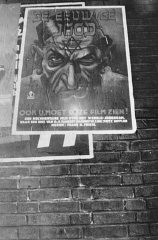
Poster calling for a boycott of German goods. Issued by the Jewish War Veterans of the United States. New York, United States, between 1937 and 1939.
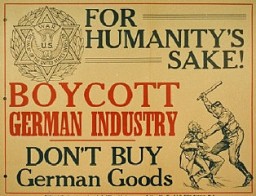
Poster for a meeting and speech about the Jewish Bolshevik threat against Germany sponsored by the local Nazi Party of East Hannover. Depicted is a silhouetted caricature of a Jewish man’s head in left profile, with a large, red Star of David beside him. The announcement at the top of the poster reads: "Victory over Bolshevism and plutocracy means being freed from the Jewish parasite!" Created ca. 1937–1940.
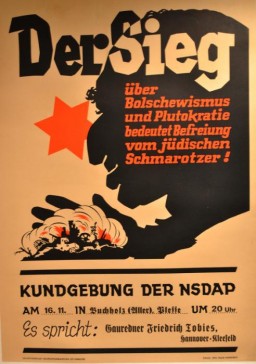
Poster for the antisemitic museum exhibition Der ewige Jude (The Eternal Jew) characterizes Jews as Marxists, moneylenders, and enslavers. Munich, Germany, November 8, 1937. Nazi propagandists also created a film of the same name.
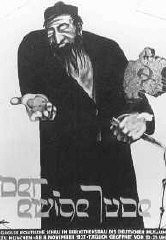
A poster in Hebrew soliciting contributions from members of the Yishuv (the Jewish community of Palestine) for army recruitment and for efforts to rescue European Jewry. The Hebrew text reads "Give a hand in rescue, the Fund for Recruitment and Rescue." Palestine, July 22, 1943.
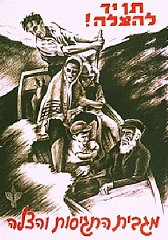
Poster: Nuremberg / Guilty! After the end of the war and the defeat of Nazi Germany, Allied occupation authorities in Germany used posters such as this one to emphasize the criminal nature of the Nazi regime.
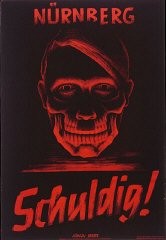
Poster promoting the Nazi monthly publication Neues Volk. Jews were not the only group excluded from the vision of the "national community." The Nazi regime also singled out people with intellectual and physical disabilities. In this poster, the caption reads: "This hereditarily ill person will cost our national community 60,000 Reichmarks over the course of his lifetime. Citizen, this is your money." This publication, put out by the Nazi Party's Race Office, emphasized the burden placed on society by…
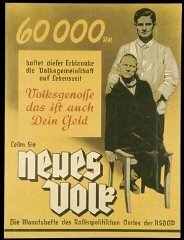
Poster: "Students/Be the Führer's propagandists." With militant appeals to nationalism, freedom, and self-sacrifice, the Nazi Party successfully recruited students disenchanted with German democracy and their current student organizations.

Poster: "We Women Are Voting Slate 2 National Socialists." German women were an important voting bloc. The Nazis made a concerted effort to appeal to women, as exemplified by this 1932 election poster. The Nazis had to repackage their messages to de-emphasize military aims. Hitler consciously modeled some Nazi propaganda appeals to German women on speeches delivered by Benito Mussolini in Fascist Italy, who also had to calm the fears of Italian war widows after World War I. Nazi propagandists attempted to…
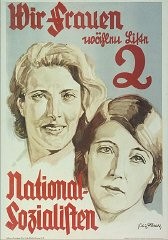
Postwar photo of a church in the village of Chelmno. Jews were kept in this building en route to the Chelmno killing center. Chelmno, Poland, June 1945.
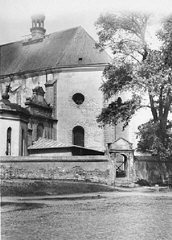
Postwar portrait of Alexander Bielski, a founding member of the Bielski partisan group. 1945–48.

Postwar portrait of Piotr Kolenda. He was a landowner from Nowogrodek who knew both the Dzienciolski and Bielski families before the war. During the war he helped hide the women before they could safely go to the forest and continued to assist members of the Bielski group while they were in the forest.
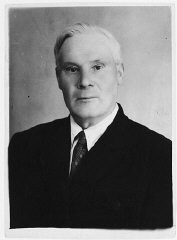
A Jewish man attempts to make a living by playing music on a gramophone, which he wheels around in an old baby carriage. Warsaw ghetto, Poland, wartime.
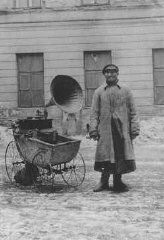
Piles of prayer shawls that belonged to Jewish victims, found after the liberation of the Auschwitz camp. Poland, after January 1945.
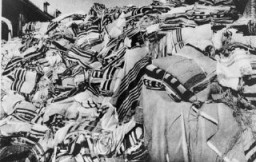
Pre-emigration training: young Jews in a cooking class in the Theodor Herzl School sponsored by the Jewish community. Berlin, Germany, between 1930 and 1939.
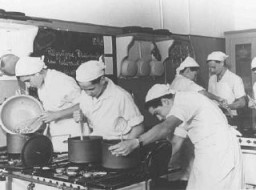
The bodies of former prisoners are laid out in rows in preparation for burial in the Ohrdruf concentration camp. Ohrdruf, Germany, April 1945.
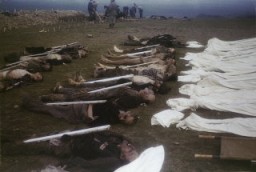
The Nazis spent large sums in preparation for the Olympic games. Here, German officials show the extent of the Olympic village using a scale model. Berlin, Germany, July 1936.
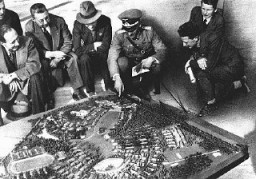
Preparation of food outside a barracks in Theresienstadt. Photograph taken after liberation. Theresienstadt, Czechoslovakia, June–August 1945.
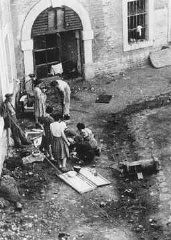
Women prepare food outdoors in the Theresienstadt ghetto. Theresienstadt, Czechoslovakia, between 1941 and 1945.
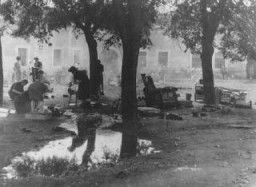
Jews interned in Cyprus prepare for Passover with supplies provided by the American Jewish Joint Distribution Committee. Cyprus, after 1945.
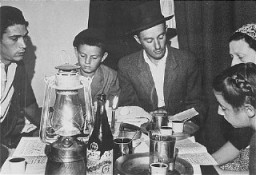
A Hungarian Jewish youth identifies the body of his father, who was shot by the SS during a death march from Flossenbürg. Members of the US military prepare the victims' burial. Neunburg, Germany, April 25, 1945.
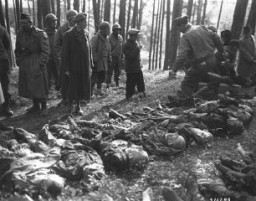
Fifteen-year-old Maria Dolezalova is sworn in as a prosecution witness at the RuSHA Trial. Dolezalova was among the children kidnapped by German forces after they destroyed the town of Lidice, Czechoslovakia. Nuremberg, October 30, 1947.
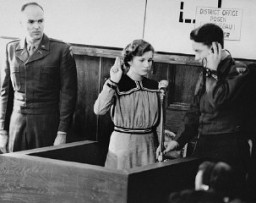
US Major Frank B. Wallis (standing center), a member of the trial legal staff, presents the prosecution's case to the International Military Tribunal at Nuremberg. A chart (top left) shows where the defendants (bottom left) fit into the organizational scheme of the Nazi Party. At right are lawyers for the four prosecuting countries. Nuremberg, Germany, November 22, 1945. The trials of leading German officials before the International Military Tribunal are the best known of the postwar war crimes trials.…
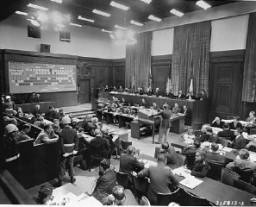
President Franklin D. Roosevelt in the Oval office at the White House, shortly before delivering a speech accepting the Democratic Party's presidential nomination. Washington, DC, United States, July 24, 1940.
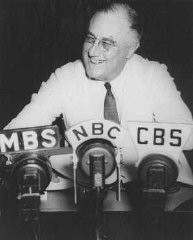
People gather in the street to read a special edition of the Nurnberger newspaper reporting the sentences handed down by the International Military Tribunal. Nuremberg, Germany, October 1, 1946.
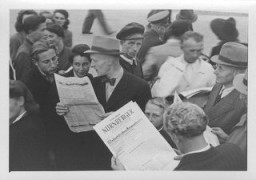
We would like to thank Crown Family Philanthropies, Abe and Ida Cooper Foundation, the Claims Conference, EVZ, and BMF for supporting the ongoing work to create content and resources for the Holocaust Encyclopedia. View the list of donor acknowledgement.